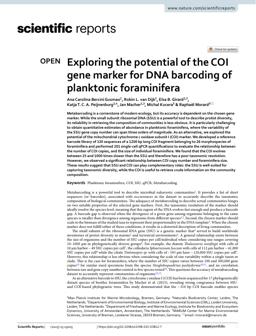2025-06-01
Exploring the potential of the COI gene marker for DNA barcoding of planktonic foraminifera
Publication
Publication
Scientific Reports , Volume 15 - Issue 19205
Metabarcoding is a cornerstone of modern ecology, but its accuracy is dependent on the chosen gene marker. While the small subunit ribosomal DNA (SSU) is a powerful tool to describe protist diversity, its reliability in retrieving the composition of communities is less obvious. It is particularly challenging to obtain quantitative estimates of abundance in planktonic foraminifera, where the variability of the SSU gene copy number can span three orders of magnitude. As an alternative, we explored the potential of the mitochondrial cytochrome c oxidase subunit I (COI) marker. We developed a reference barcode library of 130 sequences of a 1200 bp long COI fragment belonging to 26 morphospecies of foraminifera and performed 201 single-cell qPCR quantifications to evaluate the relationship between the number of COI copies, and the size of individual foraminifera. We found that the COI evolves between 25 and 1000 times slower than the SSU and therefore has a poor taxonomic resolution. However, we observed a significant relationship between COI copy number and foraminifera size. These results suggest that SSU and COI can play complementary roles: the SSU is well-suited for capturing taxonomic diversity, while the COI is useful to retrieve crude information on the community composition.
| Additional Metadata | |
|---|---|
| , , , , | |
| doi.org/10.1038/s41598-025-03842-7 | |
| Scientific Reports | |
| Released under the CC-BY 4.0 (“Attribution 4.0 International”) License | |
| Organisation | Staff publications |
|
Gusmao, Ana Carolina Bercini, van Dijk, R., Girard, E., Peijnenburg, K., Macher, J.-N., Kucera, Michal, & Morard, Raphaël. (2025). Exploring the potential of the COI gene marker for DNA barcoding of planktonic foraminifera. Scientific Reports, 15(19205). doi:10.1038/s41598-025-03842-7 |
|
